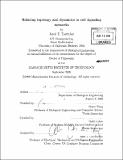Relating topology and dynamics in cell signaling networks
Author(s)
Toettcher, Jared E. (Jared Emanuel)
DownloadFull printable version (16.92Mb)
Other Contributors
Massachusetts Institute of Technology. Dept. of Biological Engineering.
Advisor
Bruce Tidor and Galit Lahav.
Terms of use
Metadata
Show full item recordAbstract
Cells are constantly bombarded with stimuli that they must sense, process, and interpret to make decisions. This capability is provided by interconnected signaling pathways. Many of the components and interactions within pathways have been identified, and it is becoming clear that the precise dynamics they generate are necessary for proper system function. However, our understanding of how pathways are interconnected to drive decisions is limited. We must overcoming this limitation to develop interventions that can fine tune a cell decision by modulating specific features of its constituent pathway's dynamics. How can we quantatively map a whole cell decision process? Answering this question requires addressing challenges at three scales: the detailed biochemistry of protein-protein interactions, the complex, interlocked feedback loops of transcriptionally regulated signaling pathways, and the multiple mechanisms of connection that link distinct pathways together into a full cell decision process. In this thesis, we address challenges at each level. We develop new computational approaches for identifying the interactions driving dynamics in protein-protein networks. Applied to the cyanobacterial clock, these approaches identify two coupled motifs that together provide independent control over oscillation phase and period. Using the p53 pathway as a model transcriptional network, we experimentally isolate and characterize dynamics from a core feedback loop in individual cells. A quantitative model of this signaling network predicts and rationalizes the distinct effects on dynamics of additional feedback loops and small molecule inhibitors. Finally, we demonstrated the feasibility of combining individual pathway models to map a whole cell decision: cell cycle arrest elicited by the mammalian DNA damage response. By coupling modeling and experiments, we used this combined perspective to uncover some new biology. We found that multiple arrest mechanisms must work together in a proper cell cycle arrest, and identified a new role for p21 in preventing G2 arrest, paradoxically through its action on G1 cyclins. This thesis demonstrates that we can quantitatively map the logic of cellular decisions, affording new insight and revealing points of control.
Description
Thesis (Ph. D.)--Massachusetts Institute of Technology, Dept. of Biological Engineering, 2009. Cataloged from PDF version of thesis. Includes bibliographical references (p. 153-163).
Date issued
2009Department
Massachusetts Institute of Technology. Department of Biological EngineeringPublisher
Massachusetts Institute of Technology
Keywords
Biological Engineering.